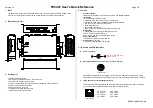
Figure 99. The
Setup>Point Mapping>Control Points
screen.
Control Point
This is the point number the SCADA system will use when operating the control point.
Code-Description
These are the point codes representing specific control points that may be assigned to
individual SCADA point numbers. Setting a code-description to the
End
option defines
the end of the configured points list and the maximum number of control points that
can be returned.
Object Type
This specifies the type of control code the SCADA master will use in the control relay
output block request. Specify the
Breaker
option for a
Trip/Close
operation, the
Latch
option for a
Latched On/Off
operation, the
Pulse
option for a momentary control output,
or the
N/A
option if the control point will not be used. The object type must be valid for
the selected object. For more information see Instruction Sheet 766-560, “IntelliRupter®
PulseCloser® Fault Interrupter:
DNP Points List and Implementation
.” The control
operation will be rejected if the object type received is a
Pulse
object type received and
there is either a
Breaker
or
Latch
mapped object type, or if there is a
Pulse
mapped
object type and either a
Breaker
or
Latch
object type is received.
Every control point configured for Breaker accepts
Latch
operations, and every
control point configured for Latch accepts
Breaker
operations.
Function Code
Control requests may be issued using the
Select/Operate
sequence, the
Direct Operate
,
and
Direct Operate No Ack
function codes.
The screen shown in Figure 99 has configuration parameters for control point
mapping. Map these points to make them available in your SCADA system.
DNP Control Points
S&C Instruction Sheet 766-530 167
Communication Setup















































